
![]()
![]()
1996 NSF Annual ReportYEAR-TWO
DEB-9505031, $227,552, 15 August 1996--31 July 1997
BIODIVERSITY OF THE KURIL ARCHIPELAGO |
|
GOALS.--Following the success of our 1994 "proof of
concept" award (see 1994 NSF Project
Report), and Year One of the present grant (see 1995 NSF Project Report), the primary goal of
this third of six expeditions to the Kuril Archipelago was to continue our
survey northward to nine islands that make up the northern part of the
chain: Matua, Raikoke, Lovushki, Shiashkotan, Ekarma, Chirinkotan,
Kharimkotan, Onekotan, and Paramushir (see
Map-based locality record browser). We also
planned to return to a number of previously under-collected localities on
central and southern islands visited in 1994 and 1995 (i.e., Urup, Iturup, and Kunashir). Reflecting a change in the scope of
the project, approved by NSF in January 1996, we determined to redirect
efforts and resources toward invertebrates (primarily terrestrial insects)
at the expense of birds and mammals (see Island Info). In every way these goals were
met.
|
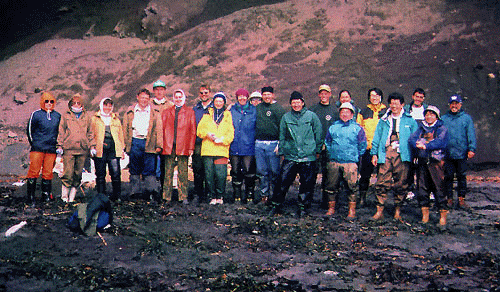 1996 IKIP participants in the field near Trudnyi River, Onekotan Island |
|
|
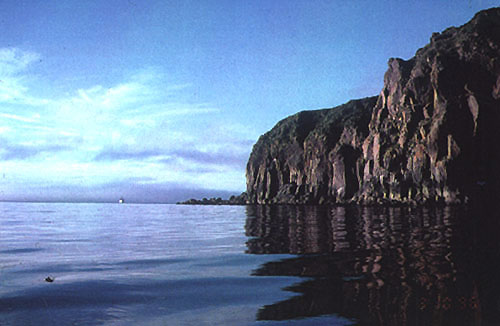 Ekarma Island; an unnamed cove just east of Cape Shipilevoy |
Collecting was confined primarily to vascular plants (but lichens, mosses, liverworts, and fungi were taken as well), aquatic and terrestrial insects, spiders and harvestmen, freshwater and terrestrial mollusks, freshwater and anadromous fishes, amphibians, and reptiles (smaller collections of platyhelminths, oligochaetes, amphipods, centipedes, millipedes, marine fishes, and marine mammals were also made). In addition to bad weather (significantly worse than we've experienced in the past), certain uncontrollable difficulties inherent in the project repeated themselves this year (such as impenetrable vegetation making adherence to transects impossible and difficult shore landings at some sites). However, the problems we experienced in 1994 of gaining access to certain islands and to sites within islands did not reoccur. Our research vessel, the 75-m AKADEMIK OPARIN, used this year instead of the smaller PROFESSOR BOGOROV, which served as our base of operations in 1994 and 1995, was very comfortable and ably managed by its Russian crew of 32 (see Russian Research Vessels). RESEARCH PRODUCTS.--Although counts are still preliminary--and despite the considerably less diverse biotas of the northern islands and fewer days in the field (compared to last year)--approximately 63,700 specimens were successfully exported to the U.S.: Plants: about 3,000 specimens of vascular plants, representing 62 families and approximately 340 species, plus 850 specimens of lichens, 650 bryophytes (mosses and liverworts), and 25 fungi, for a grand total of approximately 4,500 specimens; two or three lichen and bryophyte taxa appear to be new to science; 238 new records of vascular plants for various islands (for which plant collections have not previously been reported) and, among lichens and bryophytes, at least five new records for the Archipelago. Platyhelminthes ("planaria," i.e., the freshwater triclad genus Dugesia, etc.): 713 specimens from seven islands, all new records, collected specifically in response to a request from R. Sluys, Zoölogisch Museum, Universiteit van Amsterdam, Netherlands. Aquatic insects: 11,394 specimens, representing 38 families and a minimum of 160 species, of which one is thought to be new to science; 111 new records for various islands and 17 new records for the Archipelago. Terrestrial insects: about 27,320 specimens, representing 17 orders, about 90 families, and perhaps as many as 650 species; the material undoubtedly includes new taxa and many new records, but less than half the collection has been sorted to species and much is not yet even sorted to family. Spiders and harvestmen: 6,682 specimens, representing 31 families and 194 species, of which at least eight are thought to be new to science; at least 209 species are new records for various islands (prior to IKIP-96, spiders had never been reported from seven of the northern islands), and at least 34 species are new to the Archipelago (but much of the material remains to be sorted and identified, and much that is sorted is identified only to genus). Mollusks: 8,852 specimens, 15 families, and at least 20 species, most records of which are new for the smaller, poorly collected northern islands. Freshwater fishes: 1,562 specimens, five families, and 11 species. Marine fishes: 2,597 specimens, 11 families, and 49 species, of which one may be new to science. Amphibians and reptiles: 79 specimens, three families, and four species. |
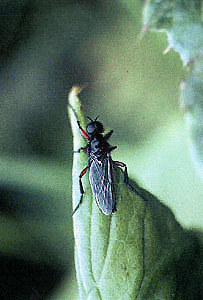
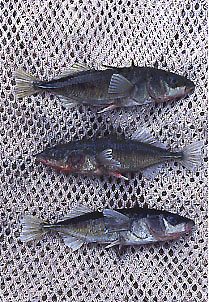 A "March fly" (Bibionidae); "3-spine sticklebacks" (Gasterosteus aculeatus) |
The plants, spiders and harvestmen, and fishes are presently being identified and cataloged here at the University of Washington in the Department of Botany, Burke Museum, and School of Aquatic and Fishery Sciences, respectively. The mollusks are being processed by Timothy A. Pearce of the Delaware Museum of Natural History, Wilmington, but eventually destined to join previously collected and cataloged IKIP material at the Museum of Zoology, University of Michigan, Ann Arbor. Curatorial work on the mollusks and vertebrates is well in hand, but much remains to be done with the plants and other invertebrates. Considerable time and effort has gone toward creating, maintaining, and updating an IKIP web-site, the heart of which is our search gateway to IKIP Databases: (1) Forms-based database search gateway, (2) Map-based locality record browser, and (3) Loans of IKIP material (please note that our IKIP web-site was developed without the use of NSF funds). Since our return from the Kurils in September 1996, we have been working hard to make all our data available electronically, but dealing with tens of thousands of specimens, it has been a major undertaking at best. All of our 1994 and 1995 locality data and most of our 1996 is on-line (2,788 sites on 19 islands) and we have entered in excess of 4,500 taxonomic records. To date, all of the following have been identified, cataloged, and made available on the web-site: all aquatic Hemiptera, Plecoptera, Trichoptera, Neuroptera, Dermoptera, aquatic beetles, spiders, mollusks, and fishes from the 1994 expedition; and all plants, Trichoptera, Neuroptera, Dermoptera, Psocoptera, aquatic beetles, mollusks, and fishes from the 1995 expedition. HUMAN RESOURCE DEVELOPMENT.--Two UW undergraduates, Birgit Semsrott (plants) and Pontus Oberg (insects) (both supported by REU funds, see below), and two UW graduate students, Noboru Minakawa (insects) and Andres Lopez (fishes), all full participants in the 1996 expedition, received training in field work, curatorial practices, and systematics within their areas of interest. Their experience continues here at home as collections are being sorted and identified, and publications prepared. |
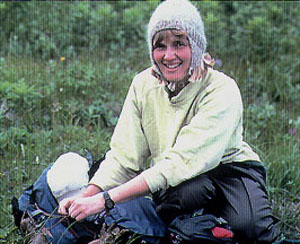 Birgit Semsrott, the newest undergraduate to join the Project |
Research Experiences for Undergraduates supplemental support received in 1996 was well used. One of the two recipients, Pontus Oberg, assisted ably in the collection of nearly 11,400 aquatic insects, which he helped to sort, label, and identify to order, much of the work accomplished while still aboard the research vessel. Since first becoming associated with IKIP in 1995, he has become interested in a study of the distribution and zoogeography of aquatic Coleoptera from the region. He is currently working on a paper with Anders Nilsson, University of Umea, Sweden; Masahiro Ohara, Otaru Museum, Otaru, Hokkaido; and Noboru Minakawa, University of Washington, titled "New Records of Aquatic Coleoptera from the Kuril Islands, Russian Far East." Another paper on aquatic Coleoptera inhabiting thermal springs on the southern Kuril Island of Kunashir is in the early stages of preparation. Pontus has not decided on an area of specialty but he is definitely on his way to becoming a professional zoologist. Birgit Semsrott, the second recipient of 1996 REU support, assisted in the collecting, sorting, and drying of plants during the 1996 expedition, helping to bring back nearly 4,500 specimens. On her own, she collected at 61 field sites, adding approximately 1,700 specimens to this year's collection. Since returning from IKIP-1996, she has worked with Collections Manager Sarah Gage in the University of Washington Herbarium to identify, label, and catalog the material. With Sarah Gage and our Japanese botanist, Dr. Hideki Takahashi, she is working on a "Flora of Chirpoi," Chirpoi being one of the most remote and least known islands of the central part of the Kuril Archipelago. In addition, she has given several botanical seminars based on her Kuril Island experience, one for the Seattle Lichen Guild and another for the UW Undergraduate Botany Club. She was also recently featured in the UW Botany Department alumni newsletter: "Botany Undergraduate Finds Adventure in the Kuril Islands," Newsletter of the Department of Botany, University of Washington, 1(1):4-5, January 1997. LOANS.--We have worked hard to make our material available to the international scientific community through loans and gifts of specimens. To date, we have sent material (whole specimens as well as tissues fixed in ethanol) to 42 specialists around the world, totalling 1,930 lots and 21,454 specimens. SEMINARS AND MEDIA ATTENTION.--We have made a concerted effort to inform academic as well as public audiences about IKIP through oral presentation, and have received considerable attention from the media in return. To date, veterans of IKIP have presented more than two dozen scientific talks and have been the subject of more than a dozen articles in newspapers and magazines. The 1996 expedition was recorded in full by three employees of the Hokkaido Television Broadcasting Co. (Yasumasa Shinomiya, writer; Osamura Hidetoshi, photographer, and Nikolai Shapotin, interpreter), resulting in a 30-minute television production that was aired in Japan on 2 March 1997. A 90-minute show on the people and general natural history of the Kuril Islands, aired in early March 1997, also featured IKIP-1996. Copies of these videos will be made available to NSF as soon as possible. "Sound bites" reported last year of some of the more exciting discoveries to date, are still being quoted by the media: "Bogs pockmarked with pools of water barely two feet across but plunging a number of unsuspecting scientists in over their heads. Scientists still aren't sure how deep the pools are because they couldn't touch the bottoms even when they knelt by the edges and reached down as far as they could with their eight-foot-long dip nets. Scientists are puzzling over the fishes found in every pool they sampled: How did the fishes get there? Are the individual "wells" connected underground?" "One small island, only five miles across, supports grasslands, large lakes, and two trees: There used to be five trees, Pietsch was told, but a tsunami 15 years ago swept across the entire island and carried three of the trees into the sea." "Bamboo forests 10 feet tall and nearly impossible to walk through that teemed with spiders--much to the delight of the expedition's arachnid expert. Last year's efforts have produced upwards of 20 never-before-seen spiders from just four islands." "An island with pools and streams of 41ºC (106ºF) water, fed by volcanic hot springs and inhabited by tiny fishes called gobies." This is probably our single most interesting finding to date: a tiny, isolated ecosystem of thick mats of bacteria, aquatic insects, and gobies, at the bottom of a deep valley on Kunashir, driven by, and maintained long-term through the severe cold of winter by hot water. We plan to return to this site during future expeditions to study its ecology; it would be especially interesting to visit this site during mid-winter, when we imagine the hot pools surrounded by three-meter "cliffs" of snow and ice. PUBLICATIONS.--Fifteen papers have now been published. An additional eight are in press, another five have been submitted, and about 20 are at various stages of preparation. Ten descriptions of new taxa have been published, or are currently in press or submitted for publication. Among our larger publication efforts is an English translation of G. O. Kryvolutskaja's Entomofauna of the Kuril Islands, originally published in 1973 by the Institute of Biology and Soil Sciences, Far-Eastern Scientific Center, Russian Academy of Science, which will be edited, augmented, illustrated in color, and made available electronically. The book is being professionally translated by Elliott B. Urdang, M.D., M.A. (in Russian), of Providence, Rhode Island. To date, the following parts of the book have been translated and delivered to us by diskette and hard-copy: the Preface (3 pages), Chapter I (History of investigations of the insect fauna of the Kuril Islands, 7 pages), Chapter II (General information on the insects of the Kuril Islands, 8 pages), and part of Chapter III (keys, descriptions, and general taxonomic accounts of Orthoptera, Homoptera, Heteroptera, and seven families of Coleoptera, all together 90 pages). All the tables (22), the legends to all the figures (67), the back-matter, and the appendix (list of plants referred to the text) are finished as well. I estimate that approximately half the work of translating is complete. We will soon begin to get the material up on the web-site. Similar plans are being made to publish electronically V. Y. Barkalov's Plants of the Kuril Islands, based on a 600-page manuscript that we hope will be made available to us in the next several months. |
 Paramushir Island; sunset in Severo-Kurilsk harbor |
PLANS FOR SUMMER 1997.--We are now in preparation for the coming summer expedition (approximately 15 July--8 September), during which time we will continue to survey the northernmost islands of the chain: Onekotan, Makanrushi, Parasmushir, Alaid, and Shumshu. We also plan to collect along the coast of Kamchatka, as well as on various central and southern islands that still have not yet been adequately collected (see Map-based locality record browser).
|
![]()